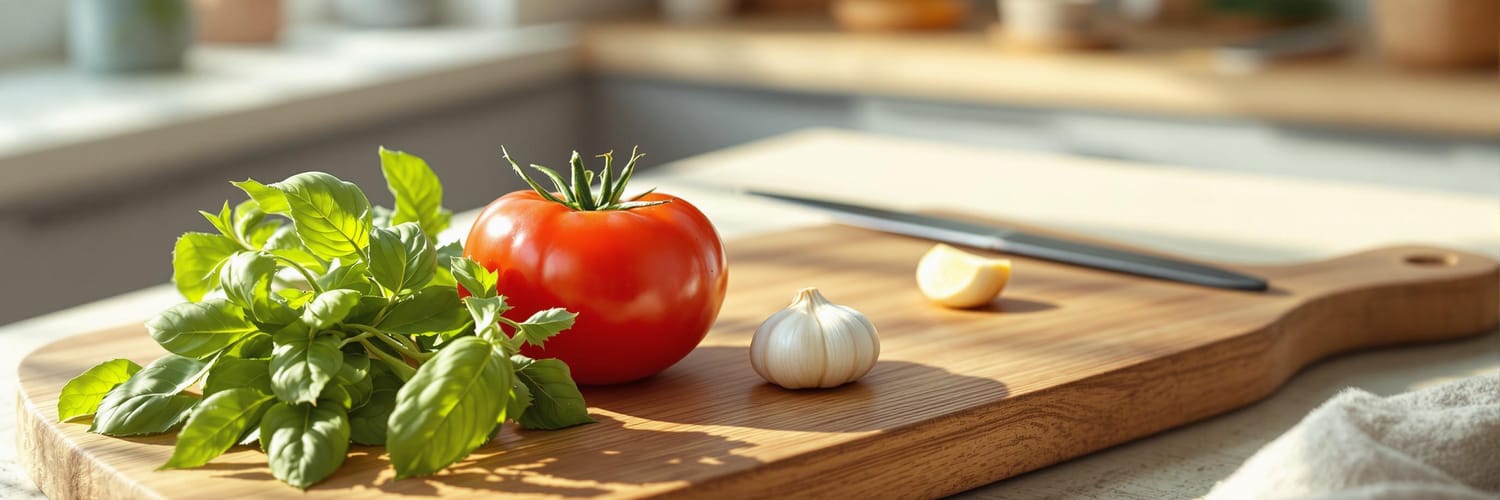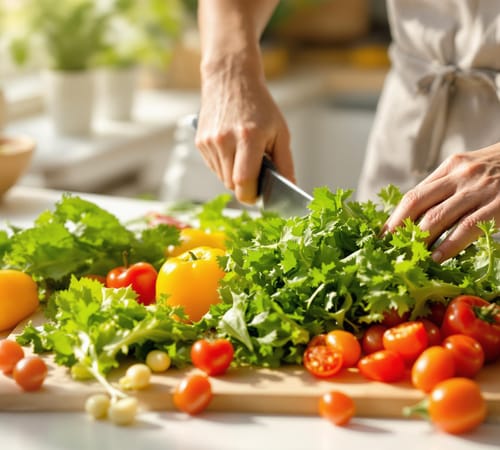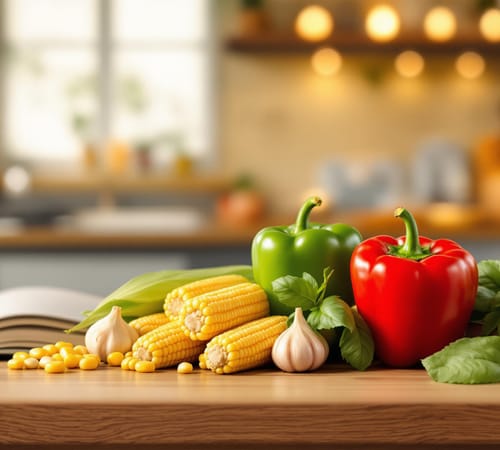You don’t need a long list of ingredients to create flavorful meals. With the right techniques and a few key items, you can make dishes that taste amazing. Here’s how:
- Season Wisely: Use salt in stages, bloom spices in oil, and balance flavors with acid or sugar.
- Leverage Aromatics: Onions, garlic, and celery build depth. Sweat for sweetness or brown for richness.
- Master Cooking Methods: Roasting, grilling, and slow cooking enhance natural flavors.
- Maximize Ingredients: Use every part - like citrus zest or vegetable scraps - to reduce waste and add flavor.
- Create Simple Condiments: Infused oils, spice pastes, and vinaigrettes can elevate any dish.
How to make your food 30x more delicious
1. Use Seasoning Effectively
Getting the most flavor out of your ingredients starts with mastering seasoning. Salt, for instance, can bring out natural flavors and turn a basic dish into something unforgettable.
Season in stages to build complexity. When cooking vegetables, add salt early - this helps draw out moisture and concentrate their flavor. Before serving, taste and adjust the seasoning as needed. For meats, salting 40 minutes to 24 hours ahead allows it to penetrate deeply, improving both taste and texture [1]. Cold dishes often need a bit more salt since flavors are less pronounced when chilled.
To bring out the full potential of spices, bloom them in oil. This simple step releases their flavors, giving your dish an extra punch [1][2]. You can also simplify your spice collection by creating versatile blends. For example, a mix of rosemary, garlic, and thyme works wonders on roasted meats and vegetables [3]. It’s an easy way to keep your pantry organized while covering a wide range of dishes.
Finally, don’t overlook the power of balance. A splash of acid or a hint of sugar can bring harmony to your dish without complicating the recipe [1][3]. Pair these with aromatics like garlic and onions for even more flavor, all with minimal effort.
2. Use Aromatics for Flavor
Aromatics like onions, garlic, celery, and carrots are the backbone of creating rich, layered flavors in your dishes - even with a short ingredient list. These ingredients quietly work their magic, adding depth and complexity to your cooking.
For a milder onion flavor, cut them pole to pole. Want a more subtle garlic taste? Slice it thinly. Adding a pinch of salt while sautéing onions not only speeds up the browning process but also boosts their flavor [1].
Sweating vs. Browning: If you're after sweet, delicate flavors, sweat your aromatics over low heat with a lid. Prefer a deeper, caramelized taste? Sauté them until they're golden brown [1][3].
Each cuisine has its go-to aromatic combinations. For example:
- French cooking often uses onions, carrots, and celery.
- Chinese dishes lean on garlic, green onions, and ginger.
- Italian recipes rely on soffritto - a mix of onions, carrots, and celery.
Adjust your chopping style depending on the dish. Roughly chop aromatics when making stocks, but finely dice them for recipes where they'll stay in the final dish. This ensures they release maximum flavor [1][3].
Aromatics don't just flavor your food - they create the enticing aromas that draw people to the table. Once you've laid this flavorful foundation, the cooking method you choose will take your dish to the next level.
3. Choose the Right Cooking Methods
The way you cook can completely change the flavor of a dish - even with just a few ingredients. Let’s break down how different techniques can bring out the best in your food.
Roasting: This method caramelizes the natural sugars in vegetables and meats, creating deep, rich flavors. To get the most out of roasting, cut your vegetables evenly and coat them lightly with oil for consistent cooking [1].
Grilling: Grilling adds a smoky, charred flavor that can make even the simplest ingredients stand out. The direct heat not only creates those iconic grill marks but also locks in moisture [1].
Here’s a quick comparison of cooking methods to help you decide what works best for your ingredients:
| Method | Best For | Temperature Range | Benefits |
|---|---|---|---|
| Slow Cooking | Tough cuts (like chuck roast) | 275°F–300°F | Tenderizes meat, builds flavor |
| Roasting | Root vegetables, tender cuts | 325°F–450°F | Caramelizes and intensifies taste |
| Grilling | Quick-cooking items, vegetables | High direct heat | Adds smoky flavor, keeps moisture |
Slow Cooking: To make the most of slow cooking, fill your cooker no more than three-quarters full. Browning meat beforehand adds extra flavor [1]. As Wine Enthusiast points out:
No cooking method is intrinsically 'better,' and an understanding of cooking methods is a key to become a better cook and a more appreciative eater [1].
Tips for Better Results:
- Use marbled cuts like beef chuck for slow cooking and finish with bold seasonings.
- Roast vegetables separately to ensure even cooking.
- When grilling, adjust heat levels based on what you’re cooking to avoid over- or undercooking.
Mastering these techniques can turn basic ingredients into standout dishes. Once you’ve nailed these methods, you’ll be ready to make the most of every ingredient while reducing waste.
4. Make the Most of Ingredients
Using every part of your ingredients not only boosts flavor but also fits perfectly with the idea of minimalist cooking - doing more with less. It’s a great way to cut down on waste while getting the most out of your grocery budget.
Here’s how you can bring out the best in common ingredients:
| Ingredient Part | Usage | Flavor Boost |
|---|---|---|
| Citrus Zest | Baked goods, dressings, pasta | Adds bright, bold citrus notes |
| Toasted Nuts/Seeds | Salads, garnishes, sauces | Brings a rich, nutty complexity |
| Vegetable Scraps | Broths, stocks, pestos | Creates a deep, savory base |
Toasting for Deeper Flavor
Toasting nuts and seeds at 160°C–180°C can transform their flavor, giving dishes a richer, nuttier profile [1].
Zero-Waste Cooking Tips
Save vegetable scraps like carrot tops or onion skins in the freezer. Use them later to make homemade broths, cutting down on waste while building layers of flavor [1]. This practice aligns with the Cooking With Less philosophy of making every ingredient count.
Quick Tips for Better Results:
- Keep a close eye on nuts while toasting - they can burn fast [1].
- Add citrus zest at the end of cooking hot dishes to keep its fresh, bright taste intact [1].
- Freeze extra zest for up to three months so you always have a flavor boost on hand [1].
"Toasting nuts & seeds can be the simplest way to unlock an unparalleled depth of flavour." [1]
Making the most of your ingredients isn’t just about saving money - it’s about creating bold, layered flavors with what’s already in your kitchen. Once you’ve mastered this, you’re ready to move on to simple condiments that pack a punch with minimal effort.
5. Make Simple Condiments
Transform basic ingredients into flavorful condiments to enhance any dish, all while keeping things straightforward.
Easy Homemade Condiments
| Type | Base Ingredients | Storage Time | Common Uses |
|---|---|---|---|
| Infused Oils | Oil + herbs/spices | 1-2 weeks (fridge) | Drizzling, cooking, marinades |
| Basic Vinaigrette | Oil + vinegar + seasonings | 2 weeks (fridge) | Salads, veggies, proteins |
| Spice Paste | Dried spices + oil/water | 1 month (fridge) | Marinades, rubs, sauces |
Infused Oils for Bold Flavor
Infuse olive oil with ingredients like garlic, rosemary, or chili flakes to create a rich, aromatic oil. Let it steep for 24-48 hours, then strain out the solids for a smooth finish.
Simple Vinaigrettes That Deliver
Mix olive oil with balsamic vinegar and freshly cracked black pepper for a classic option. Or, try avocado oil paired with apple cider vinegar and a touch of Dijon mustard for a tangy twist.
Spice Pastes for Intense Taste
Toast spices like turmeric, cumin, and coriander, then blend with oil or water to form a paste. For example, a basic curry paste might also include chili peppers for heat and depth.
These condiments are a quick way to bring new life to your meals without overcomplicating your pantry.
Wrapping Up
You don’t need a pantry packed with ingredients to whip up tasty meals. By using smart techniques and making thoughtful ingredient choices, you can create dishes full of flavor without overcomplicating things.
Here’s the key: balance and technique. Layering flavors brings depth to your cooking. Timing aromatics to preserve their oils enhances their impact. High-heat methods like roasting or caramelizing bring out natural sweetness and complexity. Making use of every part of an ingredient not only reduces waste but also adds flavor. And don’t underestimate the power of simple condiments - they can elevate even the simplest dishes.
These five approaches - seasoning wisely, using aromatics effectively, mastering cooking techniques, maximizing ingredient use, and adding condiments strategically - can help you create memorable meals with just a handful of ingredients. By putting these methods into practice, you’ll discover how to achieve bold flavors while keeping your kitchen efficient.
If you’re curious to learn more about making the most of what you have, check out Cooking With Less at cookingwithless.com. They offer tips and ideas to show how a minimalist approach in the kitchen can still deliver incredible results.
FAQs
How can you improve the flavor of food?
Bringing out great flavor with fewer ingredients comes down to smart techniques. Ingredients like citrus or vinegar can make dishes taste brighter, while condiments like mustard or salsa add boldness without much effort.
Here are some effective ways to boost flavor while keeping things simple:
| Technique | How to Use It | What It Does |
|---|---|---|
| Acidic Ingredients | Add citrus juice, vinegar, or other concentrated flavors | Makes dishes taste brighter and more dynamic |
| Toasting Spices | Gently toast spices before using them | Adds depth and richness |
| Flavorful Condiments | Use small amounts of bold condiments like mustard or salsa | Packs a punch without overcomplicating |







